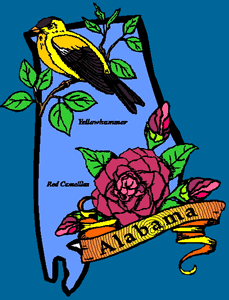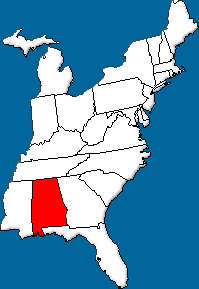


Geography and Landforms: Alabama is comprised of coastal plains at the Gulf of Mexico sloping into hills and broken terrain in the north. Two thirds of the state are covered by the East Gulf Coastal Plain, including swamps. Above the coastal plain is the Appalachian Piedmont. The highest point in Alabama is Cheaha Mountain at 2,407 feet, near Lineville. Major rivers include the Tombigbee, the Alabama, the Tennessee and the Chattahoochee. Russell Cave National Monument, near Bridgeport, is the site of caves that were inhabited continuously from 6000 B.C. to A.D. 1650. |
 History:
The first European to explore Alabama was Alonzo Alvarez de Pineda of Spain, who explored the Gulf of Mexico from Florida to Mexico in 1519, including the area we now call Mobile Bay. The Spaniard Panfilo de Narvaez attempted to start a colony in 1528 along the Florida Gulf Coast, but was unsuccessful. Hernando de Soto, also from Spain, explored the Southeast, coming into conflict with Chief Tuskaloosa in the Battle of Maubila in 1540. De Soto destroyed the Indian village and most of its more than 2,000 residents. Another Spaniard, Don Tristan de Luna failed to establish a permanent Spanish colony on the Alabama Florida coast between 1559 and 1561.
|
 Economy:
About half of Alabama's area is devoted to agriculture, and the state ranks third in US broiler chicken production. Cotton is the chief agricultural crop, along with peanuts and vegetables.
|
 First Inhabitants:
The first inhabitants of the area we now call Alabama were semi-nomadic hunter-gatherers who lived in caves or in the open countryside around 10,000 years ago. Eventually, people began to build temporary shelters, and expanded their diet to include shellfish found in the Gulf of Mexico. They made spears (called atlatls) and used them to hunt small game. By about 4,000 years ago, these people had begun to create distinctive pottery, and then built more permanent houses, developed bows and arrows, and learned to cultivate maize and squash.
|
Books Related To AlabamaBird - Angela Johnson Fake ID - Walter Sorrells The Hanging Woods - Scott Loring Sanders Hard Times for Jake Smith - Aileen Kilgore Henderson Inside Out and Back Again - Lai Thanhha Looking for Alaska - John Green Miss Spitfire: Reaching Helen Keller - Sarah Miller Singing Hands - Delia Ray The Stones of Mourning Creek - Diane Les Becquets The Thanksgiving Visitor - Truman Capote Walking to the Bus-Rider Blues - Harriette Gillem Robinet Y is for Yellowhammer: An Alabama Alphabet - Carol Crane |
Famous Citizens:
|
| Capital: | Montgomery |
| Entered Union: | December 14, 1819 |
| Population: | 4,802,982 |
| Area | 52,419 |
| Bird | Yellowhammer |
| Flower | Camellia |
| Nickname: | Yellowhammer State |
| Governor | Robert Bentley |
Places to Visit in Alabama: (Click the links to learn more.)
|



